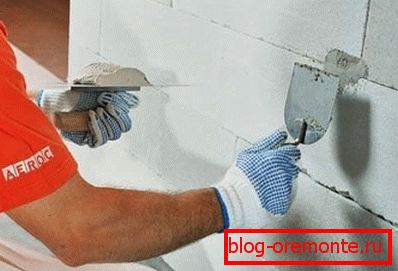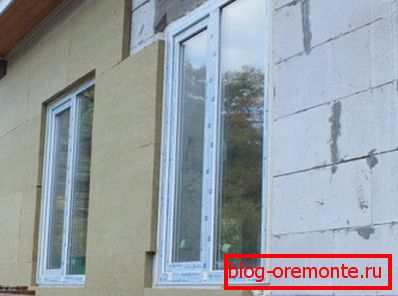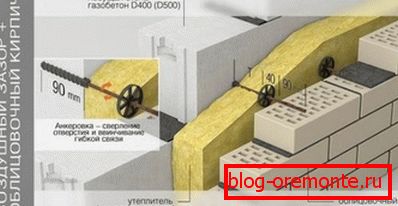Warming of the walls of aerated concrete. adhesive method.
Porous concretes, among other advantages, are also distinguished by higher thermal insulation characteristics. And yet, the insulation of the walls of aerated concrete from the inside and outside allows you to optimize the heat exchange of the building, radically improve the microclimate and reduce the cost of heating it.
Naturally, for the implementation of this project at the proper level, we will need some knowledge. That is why we strongly recommend that you carefully study this article before starting work.

Inside or outside?
Теплоизоляция сооружений из пористых бетонов может осуществляться как с внутренней, так и с наружной стороны (читайте также статью «Ленточный бетонный фундамент: его свойства и технология закладки»).
However, from the point of view of building heat engineering, the second option is more preferable, and here's why:
- Placing insulation on the inside of the wall, we thereby shift the temperature gradient into the interior. Because of this, there is a risk of condensation in the thickness of the insulation due to the dew point falling exactly on the wall.
Note! The dew point is the temperature at which water vapor begins to condense and fall on the surface in the form of small droplets.
- The unpleasant consequences of this phenomenon include increasing the humidity inside the room, the risk of fungus on the walls, as well as partial decomposition of thermal insulation materials. Particularly affected products, which include organic components.
- This can be avoided, but then it is necessary to add a layer of waterproofing material and a ventilated membrane to the design of the insulation layer. As a result, the price of finishing will increase.
- But the exterior finish is devoid of these disadvantages, so that you can not worry about the condensate. At the same time, it is somewhat more difficult to implement, especially on the upper floors of buildings: either forests or equipment for industrial mountaineering will be needed.

Tip! The instruction requires to consider all the works that are carried out above the second floor, high-altitude. Accordingly, only those who have the appropriate tolerance can carry them out.
As you can see, it is better to warm outside. And let this process be more laborious, but as a result we will get much less problems with condensate and fungus. Yes, and it will be warmer!
Preparatory work
The choice of thermal insulation material

Warming of external walls of aerated concrete can be carried out using various means. And yet, in most cases, use either polymer plates or materials based on mineral wool.
Each of these options has its own characteristics, which we analyze in the form of a table:
| Styrofoam and analogues | Heat insulation materials | |
| Virtues |
|
|
| disadvantages |
|
|
- Expanded polystyrene is widely used for pasting walls, followed by plastering and painting. At the same time, pasting the facade with polystyrene foam partially violates natural ventilation, since this material is vapor-proof. That is why in this case it is desirable to install additional devices for ventilation (window valves, recuperators, etc.).
Tip! Do not use foam panels instead of polystyrene. Firstly, they withstand mechanical loads worse, and secondly, they are much more flammable.

- An alternative to polymer slabs are mineral wool based mats. In this case, the insulation will cost a bit more expensive, but problems with ventilation can be avoided.
- Dense mats can be plastered, but most often mineral wool is masked with hinged front panels or siding.
In addition, for this purpose you can also use polyurethane, foam glass, ecowool and other materials.
Separately, it is necessary to stipulate the situation when wall insulation is performed with aerated concrete blocks on concrete or brick. In this case, the porous material itself plays the role of a heat insulator, and our task is to maximally protect its surface from moisture and external influences.
Wall processing
Before embarking on thermal insulation, it is necessary to prepare the base.
For this:
- Thoroughly dry the walls of aerated concrete. If during the construction of the building they did not get wet, then the work can be started immediately, but if the work was performed without overlapping, then drying is mandatory for at least three months.
Note! Otherwise, moisture trapped in the thickness of the material will be “locked” with insulation, which will lead to freezing of the walls.
- Next we need to carefully inspect all the seams.. If an adhesive composition was used, their size will be minimal, but the seams from the mortar must be re-sealed. Best of all, polyurethane foam is suitable for this.

- With the same foam we fill all cracks and voids that appeared after the completion of construction.
- Finally, to ensure the adhesion of the adhesive composition, we treat the surfaces with sandpaper. So we will open the outer pores on each block and increase the strength of adhesion of the base to the insulation.
Also, before starting work, it is necessary to equip channels for communications, if this has not been done before. Diamond drilling of holes in concrete is used for this: in this way we will get the most even and clean holes.
Method of insulation
Adhesive method
The insulation procedure itself can be implemented in two ways.
The first scheme is simpler to do it yourself and involves the use of special adhesives:
- The prepared wall surface is treated with a penetrating primer with antiseptic components.
- Apply cement-based adhesive to polystyrene plates.
Tip! If the walls have irregularities (they occur when not whole blocks were used, but the reinforced concrete was cut with diamond circles), then glue can be additionally applied to the substrate.

- Plates are glued to the wall in such a way that the seams do not coincide. The optimum is offset by half the width of the slab, as when laying bricks.
- To increase strength, we fix the heat insulator with dish-shaped dowels. Dowels drive in the corners of each plate, as well as in the center.
- The seams and voids between the sheets of insulation are filled with polyurethane mounting foam.
- Then we attach a plaster net of alkali-resistant polymers to the polystyrene layer.
At the final stage we level the wall with plaster, we putty and paint it with a compound for facade works. It is advisable to make the plaster layer not too thick, otherwise the heat insulator will begin to fall off from the base under its own weight.
Alternatively, you can veneer the wall with decorative brick, linking it to the supporting structure of steel mortgages.

This technology can also be used for thick mats based on mineral wool, but most often this material is mounted under the skin. How to do this, we will explain in the next section.
Dry heat insulation
The hinged ventilated facade has a number of advantages: it is less demanding in its maintenance, well protects heat-insulating materials from damage, and does not interfere with air circulation. Nevertheless, wall insulation with gas concrete according to this method is carried out relatively infrequently.

The reason is the following: porous concrete is less durable than ordinary concrete or brick, so that the walls can be destroyed under the influence of heavy loads. That is why only the lightest panels, such as vinyl siding, are used for such finishes.
Methodology:
- We fix brackets on the wall, on which guides will be installed later. To avoid the formation of "cold bridges" under the base of each bracket, experts recommend laying a layer of paronite or similar incompressible material.
Tip! Fastening is carried out on an anchor with a plastic sleeve, because metal parts can cause the destruction of the concrete layer and the weakening of fasteners.
- On top of the brackets we mount plates of mineral wool, cutting the insulation with a knife. For fastening use plastic dowels with disc stopper.
- The gaps between the plates are filled with scraps of material and self-expanding foam.
- A windproof membrane is laid on top of the insulation layer. It is desirable that it be vapor-permeable - then the risk of condensation on the mineral wool layer will be minimal.
- On the protruding parts of the brackets we mount the guides. Between them and the insulation should form an air gap, which will provide ventilation.

Then we can only protect our facade:
- We fasten stronger and thicker siding to the basement part. Here you can not be afraid of damage, because the load on the supporting structure will be minimal.
- Wall sheathe siding, not forgetting to leave a gap for air circulation.
- At the corners of the house, as well as the junction of door and window openings we put on special lining.
Conclusion
Утепление стен из газобетона снаружи под сайдинг, а также оклейка стен полимерными теплоизоляторами являются оптимальными методами для сохранения тепла в таком здании. Несмотря на хорошие эксплуатационные свойства пористого бетона пренебрегать подобными мероприятиями не стоит, так как они позволяют существенно сэкономить на отоплении (см.также статью «Грунтовка для бетона - виды, особенности, правила применения»).
Well, how to do all the work correctly, you can find out by viewing the video in this article.